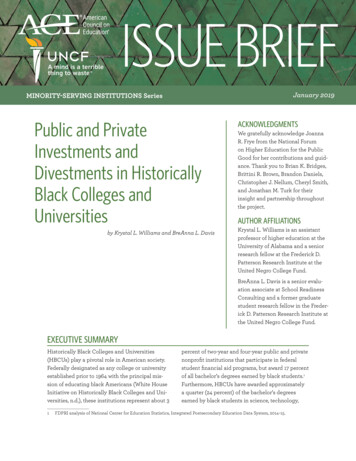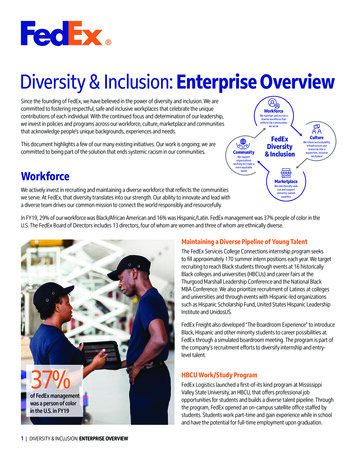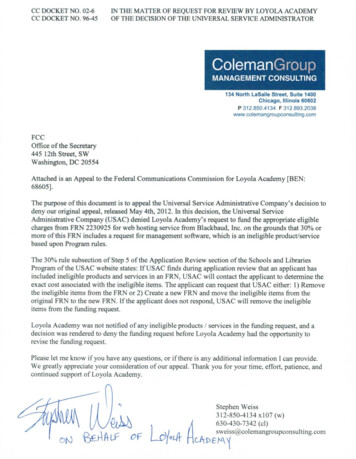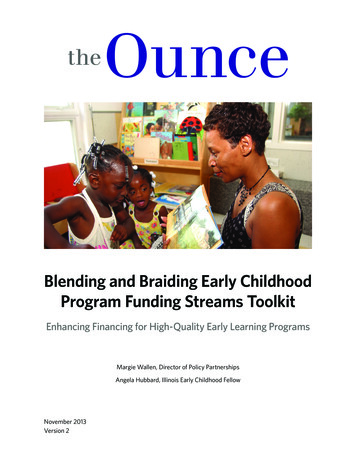
Transcription
AmericanCouncil onEducationISSUE BRIEFJanuary 2019MINORITY-SERVING INSTITUTIONS SeriesPublic and PrivateInvestments andDivestments in HistoricallyBlack Colleges andUniversitiesby Krystal L. Williams and BreAnna L. DavisACKNOWLEDGMENTSWe gratefully acknowledge JoannaR. Frye from the National Forumon Higher Education for the PublicGood for her contributions and guidance. Thank you to Brian K. Bridges,Brittini R. Brown, Brandon Daniels,Christopher J. Nellum, Cheryl Smith,and Jonathan M. Turk for theirinsight and partnership throughoutthe project.AUTHOR AFFILIATIONSKrystal L. Williams is an assistantprofessor of higher education at theUniversity of Alabama and a seniorresearch fellow at the Frederick D.Patterson Research Institute at theUnited Negro College Fund.BreAnna L. Davis is a senior evaluation associate at School ReadinessConsulting and a former graduatestudent research fellow in the Frederick D. Patterson Research Institute atthe United Negro College Fund.EXECUTIVE SUMMARYHistorically Black Colleges and Universities(HBCUs) play a pivotal role in American society.Federally designated as any college or universityestablished prior to 1964 with the principal mission of educating black Americans (White HouseInitiative on Historically Black Colleges and Universities, n.d.), these institutions represent about 31percent of two-year and four-year public and privatenonprofit institutions that participate in federalstudent financial aid programs, but award 17 percentof all bachelor’s degrees earned by black students.1Furthermore, HBCUs have awarded approximatelya quarter (24 percent) of the bachelor’s degreesearned by black students in science, technology,FDPRI analysis of National Center for Education Statistics, Integrated Postsecondary Education Data System, 2014–15.
private HBCUs relative to their non-HBCUcounterparts (17 percent versus 25 percent).engineering, and mathematics (STEM) since theearly 2000s (Williams and Preston, forthcoming).This issue brief summarizes the federal, state, andlocal funding sources of HBCUs and non-HBCUs—in addition to private institutional investments—toillustrate continuing disparities in how collegesand universities secure resources. Both public and private HBCUs experiencedthe steepest declines in federal funding perFTE student between 2003 and 2015, withprivate HBCUs seeing a 42 percent reduction—the most substantial of all sectors.Key findings include: Within both public and private sectors, HBCUendowments lag behind those of non-HBCUsby at least 70 percent; this gap jeopardizes anHBCU’s ability to buffer decreases in state andfederal funding. Public HBCUs rely on federal, state, and localfunding more heavily than their non-HBCUcounterparts (54 percent of overall revenueversus 38 percent). Confirming a commonly held belief, privateHBCUs are slightly more tuition-dependentthan their non-HBCU counterparts (45 percenttuition-dependent compared with 37 percenttuition-dependent). Private gifts, grants, and contracts make upa smaller percentage of overall revenue forThese key findings reveal one overarching difference in funding between HBCUs and non-HBCUs:despite efforts to counter a historical legacy ofinequitable funding and notable investments bythe federal government and many state governments, resource inequities continue to plagueHBCUs.FUNDING EDUCATION AT HBCUsRising college costs, student debt, and federalbudget cuts have positioned higher educationfinance as a pressing issue within policy circlesand among the broader public (Jaschik 2017; Rothman 2016; Saunders, Williams, and Smith 2016).Given concerns about college finance, it is important to understand the broader context of revenuestreams for both public and private institutions.This is especially important for institutions suchas HBCUs, where over 70 percent of studentshave limited financial resources to pay for collegeand rely heavily on other forms of aid (Saunders,Williams, and Smith 2016). Given the financialconstraints of many HBCU students, it is importantto better understand the various sources of revenuethat these institutions pull from besides tuition andfees.Funding for American colleges and universitiesis derived primarily from 1) public sources (e.g.,federal, state, and local appropriations, grants andcontracts), 2) private investments (e.g., gifts, grants,and contracts), 3) tuition and fees, and 4) otherincome (e.g., auxiliary income). While both HBCUsand non-HBCUs rely on each of these fundingstreams, they do so to varying degrees. This briefexamines these revenue sources to illuminate howHBCUs are funded compared with non-HBCUs.The data also demonstrate how these sources havebeen historically inequitable and continue thattrend in the present day. All estimates focus specifically on four-year public and private nonprofitinstitutions.Public and Private Investments and Divestments in Historically Black Colleges and Universities2
TOTAL REVENUE SOURCESFigure 1 provides insights about how institutional revenue for public and private HBCUs andnon-HBCUs is driven by different sources.2 Theseestimates illustrate proportional revenue contributions from the sources noted previously.Figure 1. Average Revenue Shares at Public and Private Nonprofit Four-Year HBCUs and Non-HBCUs, 201525%25%Private NFP 4-Year Non-HBCUs37%17%Private NFP 4-Year HBCUsPublic 4-Year Non-HBCUs 4%Public 4-Year HBCUs 1%9%45%27%27%12%38%29%26%31%54%19%Private Gifts, Grants, and Contracts*Federal, State, and Local Appropriations, Grants, and ContractsNet Tuition RevenueAuxiliary and Other IncomeSource: National Center for Education Statistics, Integrated Postsecondary Education Data System*Includes investment income such as interests on endowments.Note: Totals may not add up to 100 due to rounding.The data demonstrate that public institutionsreceive a greater proportion of their overall fundingfrom federal, state, and local resources than privateinstitutions. However, reliance on these sourcesdiffers between publicHBCUs and public nonFINDING 1HBCUs. Among publicPublic HBCUs rely on federal,institutions, HBCUs arestate, and local funding moremore dependent on fundingheavily than non-HBCUs (54from federal, state, and localpercent of overall revenue vergovernments than nonsus 38 percent).HBCUs (54 percent of theirrevenue compared with 38percent). These estimates donot suggest that the total amount of federal, state,and local funding that public HBCUs receive is23greater than public non-HBCUs. In 2015, publicfour-year HBCUs received about 2.2 billion infederal, state, and local funds, while non-HBCUsreceived a little over 94 billion from the samesources. However, when overall revenue is examined, these sources simply provide a larger share oftotal revenues at publicHBCUs relative to theirFINDING 2public non-HBCU counter3parts. Although privatePrivate HBCUs are slightly moreinstitutions are generallytuition-dependent than theirless dependent on publicnon-HBCU counterparts (45sources, it should also bepercent more tuition-dependentnoted that private HBCUscompared with 37 percent).receive a larger share of theirfunding from these sourcesAll HBCU estimates exclude Howard University (DC) because of the unique funding arrangement resulting from its status as acongressionally chartered institution.The difference in revenue shares for public HBCUs and non-HBCUs from public sources reflects the fact that HBCUs have a loweramount of overall revenue; the federal, state, and local funding that they receive represents a larger share of their smaller income.Public and Private Investments and Divestments in Historically Black Colleges and Universities3
than private non-HBCUs (12 percent of theirrevenue compared with 9 percent).While public funds are the largest source of revenue for public institutions, private institutionsare generally more tuition dependent (i.e., privateinstitutions depend more heavily on tuition andfees for their funding than public institutions).This also holds true for both HBCUs, with privateHBCUs receiving a larger percentage of their overall revenue from tuition and fees (45 percent versus37 percent). In addition, without the same degreeof public financial support, private colleges anduniversities rely heavily on funding from privategifts, grants, and contracts, as well as auxiliaryand other sources of income (e.g., residence halls,food services, book stores, parking, intercollegiateathletics).Although private investments are critical sourcesof funding for many private institutions, theproportion of universities’overall budget from theseFINDING 3sources is higher for privatePrivate funds make up a largernon-HBCUs than privatepercentage of overall revenueHBCUs (25 percent comfor private non-HBCUs relativepared with 17 percent; seeto their HBCU counterparts (25Figure 1). Furthermore,percent versus 17 percent).private non-HBCUs receivea slightly higher proportion of their overall revenuefrom auxiliary and other sources compared withprivate HBCUs (29 percent versus 26 percent). It isalso worth noting that auxiliary and other incomecompose a considerably higher percentage ofrevenue for public non-HBCUs than their HBCUcounterparts (31 percent versus 19 percent).Figure 1 reveals just how unique HBCU fundingprofiles are in three key areas: public sector support(e.g., federal, state, and local appropriations; grantsand contracts), private investments (e.g., gifts,grants, and contracts), and tuition revenue. Withinboth the public and private sectors, funding frompublic sources makes up a larger share of the funding profiles of HBCUs compared with non-HBCUinstitutions. This underscores the importance of ahealthy partnership between HBCU leadership andfederal, state, and local governments for continuedinstitutional vitality. Compared with their privatenon-HBCU peers, private HBCUs benefit less fromprivate investments. Ultimately, the limited privatefunds for private HBCUs further explain theirdependence on tuition revenue. Moreover, theirreliance on governmental funds further emphasizesthe importance of public support. The followingsections provide more detailed insights aboutHBCU funding from public and private sources,relative to non-HBCUs.FEDERAL FUNDING FOR HBCUs AND NON-HBCUsThe U.S. Department of Education (ED) providesthe bulk of federal funds to colleges and universities indirectly through the federal student aidprograms via Title IV of the Higher Education Act(HEA). HBCUs also receive direct subsidies fromED through Title III, Part B of the HEA, which“provides financial assistance to Historically BlackColleges and Universities (HBCUs) to establish orstrengthen their physical plants, financial management, academic resources, and endowment-building capacity” (U.S. Department of Education 2017).HBCUs receive this direct funding for operationsfrom the federal government because of theirsignificant contributions to promoting equalopportunity, to correct decades of discriminatorypractices by the federal and state governments,and to build their operational capacity. In FY 2015,HBCU received a total of 227,524,000 in fundsfrom Title III, Part B (U.S. Department of Education 2017). HBCUs also receive smaller awardsfrom various federal agencies including the U.S.Department of Health and Human Services, theNational Science Foundation, and U.S. Departmentof Defense (U.S. Department of Education 2015).Figure 2 provides information about the federalfunds awarded to HBCUs per FTE student fromPublic and Private Investments and Divestments in Historically Black Colleges and Universities4
2003 to 2015.4 The data show that federal supportper FTE has decreased over time for each type ofinstitution. This decline hasbeen most pronounced forFINDING 4private HBCUs, whereBoth public and private HBCUsfederal funding per FTEexperienced the steepestdecreased from about 4,300declines in federal funding perin 2003 to approximatelyFTE student between 2003 2,500 in 2015, a decline ofand 2015, with private HBCUs42 percent. The data alsoseeing the most substantialindicate some disparities inreduction (42 percent).federal funding betweenHBCUs and non-HBCUs.Although private HBCUs and private non-HBCUsreceived comparable federal funding per FTE inthe early 2000s, a substantial funding gap emergedin 2006 that has continued to widen. The mostrecent estimate indicates that private HBCUsreceive about 1,600 less in federal funding perFTE compared with private non-HBCUs. In 2003,the gap was less than 400 per FTE, as shown inFigure 2. Overall, this funding disparity illuminatesa need for better insights about the distribution offederal funds. Other research supports the need toincrease HBCU participation in federal programsand initiatives, including competitive grants andcontracts, and to strengthen HBCUs’ capacity tocompete for federal awards (Toldson and Washington 2015).Figure 2. Federal Funding per FTE Student at Public and Private Nonprofit Four-Year HBCUs and NonHBCUs, 2003–15 (Adjusted for Inflation) 6,000 5,000 4,000 3,000 2,000200320042005200620072008 20092010201120122013Public Four-Year HBCUsPublic Four-Year Non-HBCUsPrivate NFP Four-Year HBCUsPrivate NFP Four-Year Non-HBCUs20142015Source: National Center for Education Statistics, Integrated Postsecondary Education Data System4These estimates include the total amount of revenue from federal appropriations, grants, and contracts. Pell Grants are excluded ifthey were reported as federal grants. All dollar amounts are adjusted to represent 2015 dollars.Public and Private Investments and Divestments in Historically Black Colleges and Universities5
STATE AND LOCAL FUNDING FOR HBCUs AND NON-HBCUsIn addition to federal funding, state, and localappropriations provide a valuable source of revenue for colleges and universities, especially thosein the public sector. Unfortunately, states havedivested from higher education over the last fourdecades (Seltzer 2018), leaving HBCUs especiallyvulnerable. Figure 3 illustrates state and localappropriations from 2003 to 2015 for HBCUs andnon-HBCUs, demonstrating downward trends instate support.5 Given the small amount of fundingthat private colleges and universities receive fromstate and local governments, these estimates focusexclusively on public institutions.Figure 3. State and Local Appropriations per FTE Student at Public Four-Year HBCUs and Non-HBCUs,2003–15 (Adjusted for Inflation) 12,000 11,000 10,000 9,000 8,000200320042005200620072008 2009Public Four-Year HBCUs201020112012201320142015Public Four-Year Non-HBCUsSource: National Center for Education Statistics, Integrated Postsecondary Education Data SystemFrom 2003 to 2015, state and local appropriationsper FTE to all four-year institutions decreased.Despite the economic rebound since the 2008recession (Geewax 2016), state financial support forhigher education has not recovered to pre-2008levels. The reduction in state support for publicinstitutions has caused some to question stategovernments’ valuation of education as a collectivegood with broader societal benefits (Hebel 2014).Although the national data in Figure 3 suggest thatpublic HBCUs and non-HBCUs have been fundedat similar levels per FTE student since 2008, it isimportant to note that these trends may differ at5the state level, with some states having noted disparities in funding, including Louisiana and NorthCarolina (Boland and Gasman 2014), as well as Alabama, Florida, and Texas (Lee and Keys 2013). Theexistence of comparable levels of funding at thenational level for public HBCUs and non-HBCUsin the last several years of the data is a promisingsign. However, individual state data need to bedisaggregated to determine whether this is a broadtrend or one that is driven by a few states that havemade targeted investments, which is beyond thescope of this paper.All dollar amounts are adjusted to represent 2015 dollars.Public and Private Investments and Divestments in Historically Black Colleges and Universities6
HBCU AND NON-HBCU ENDOWMENTSIn addition to public sources of funding, mostcolleges and universities—particularly privates—leverage their endowments for items such asinstitutional grants and operating costs.Endowments—and other private sources ofmoney—allow institutions to minimize tuitionincreases, to provide high-quality services at alower cost to students than would otherwise befeasible, and to support other things that contributeto institutional quality, such as faculty positions,medical research, and libraries (ACE 2014). Figure4 reveals stark differences in endowment assets perFTE student for HBCUs and non-HBCUs. Ingeneral, non-HBCUs reported greater endowmentsthan their HBCU peers. The most recent dataindicate that, per FTE student, the endowment forpublic HBCUs was about 20 percent of theendowment for public non-HBCUs. For privateinstitutions, the endowment for HBCUs is about 27percent of the endowment at non-HBCUs. It followsthat non-HBCUs have more endowment income todeploy when confronted with economic downturnsand public financial divestments. Private HBCUsare acutely affected by this given that privateinstitutions are moreFINDING 5financially dependent ontheir endowment earningsWithin both public and privatethan their publicsectors, HBCU endowments lagcounterparts. Differencesbehind those of non-HBCUs byin endowment assets stemat least 70 percent, which jeoppartially from longardizes the HBCU leadership’sstanding imbalances in theability to buffer decreases inamount of private fundsstate and federal funding.acquired by HBCUscompared with nonHBCUs. Some of the fundraising difficulties thatHBCUs face include unequal consideration forfunding by foundations and corporate donors, aswell as challenges with alumni giving (Gasman2010). HBCUs may also receive less in private giftsbecause of ever-growing gaps in racial wealth(Asante-Muhammed et al. 2016), which can put thepreponderance of HBCU alumni at a disadvantageto support philanthropic efforts. When taken inconcert with continuing decreases in publicfunding for higher education, the lower endowmentlevels of HBCUs present a significant resourceconstraint.Figure 4. Endowment Assets per FTE Student at Public and Private Nonprofit Four-Year HBCUs and NonHBCUs, 2003–15 (Adjusted for Inflation) 150,000 120,000 90,000 60,000 30,0000200320042005200620072008 20092010201120122013Public Four-Year HBCUsPublic Four-Year Non-HBCUsPrivate NFP Four-Year HBCUsPrivate NFP Four-Year Non-HBCUs20142015Source: National Center for Education Statistics, Integrated Postsecondary Education Data SystemPublic and Private Investments and Divestments in Historically Black Colleges and Universities7
CONCLUSIONHBCUs are critical access points to postsecondaryeducation and serve an important function inpromoting educational attainment, particularly formany black students. In addition, these institutionsserve a significant proportion of first-generationstudents and those who require financialassistance to afford college—a growing segmentof the college-going demographic within theUnited States (College Board 2015). HBCUs alsocontribute substantially to the national economy,providing over 134,000 jobs and 14.8 billion ineconomic impact in 2014 alone (Humphreys 2017).Despite these contributions to society, HBCUscontinue to grapple with funding challenges thatare beyond their control. As a result, HBCUs mustrely more heavily on tuition and fees and publicsources of funding—federal and state support—tofund their operations. While student tuition andfees are important for the financial viability of allinstitutions, their higher level of dependence ontuition dollars leave many HBCUs more vulnerableto swings in enrollment. The greater reliance ofHBCUs on federal and state support, in comparisonwith their non-HBCU counterparts, also makesthem susceptible to economic downturns, statedivestments from higher education, or policychanges, as witnessed during the 2012 Parent PLUSloan crisis. The crisis made it more difficult forfamilies to borrow money for college and prompteda drop in student enrollment at many blackinstitutions (Wang 2013). Creating a better balanceof funding sources along with endowment growthwill help HBCUs better prepare for a future thatwill likely be characterized by diminishing publicsupport for postsecondary education.Because HBCUs are mission-driven to broadencollege opportunities for black students, manyof whom have limited financial resources, thesecolleges and universities cannot increase coststo offset public divestments in higher education.Furthermore, they cannot grow their endowmentsovernight. As a result, federal, state, and local funding continue to play a critical role for HBCUs intheir mission to support students that the countryneeds to earn college degrees.Public and Private Investments and Divestments in Historically Black Colleges and Universities8
REFERENCESACE (American Council on Education). 2014. Understanding College and University Endowments.Washington, DC: ACE. nding-EndowmentsWhite-Paper.pdf.Asante-Muhammed, Dedrick, Chuck Collins, Josh Hoxie, and Emanuel Nieves. 2016. The EverGrowing Gap: Without Change, African-American and Latino Families Won’t Match White Wealth forCenturies. Washington, DC: CFED and Institute for Policy Studies. he-Ever-Growing-Gap-CFED IPS-Final-2.pdf.Boland, William Casey, and Marybeth Gasman. 2014. America’s Public HBCUs: A Four State Comparisonof Institutional Capacity and State Funding Priorities. Philadelphia: Center for Minority ServingInstitutions. http://www.gse.upenn.edu/pdf/cmsi/four state comparison.pdf.College Board. 2015. Trends in Student Aid 2015. Washington, DC: College Board. /trends-student-aid-web-final-508-2.pdfGasman, Marybeth. 2010. Comprehensive Funding Approaches for Historically Black Colleges andUniversities. Philadelphia: University of Pennsylvania. hesHBCUs.pdf.Geewax, Marilyn. 2016. “U.S. Economic Recovery Looks Good Compared with Sluggish Europe, Asia.” NPR,June 17, 2016. d-with-sluggish-europe-asia.Hebel, Sara. 2014. “From Public Good to Private Good: How Higher Education Got to a Tipping Point.”The Chronicle of Higher Education, March 2, 2014. ivate/145061.Humphreys, Jeffrey M. 2017. HBCUs Make America Strong: The Positive Economic Impact of HistoricallyBlack Colleges and Universities. Washington, DC: UNCF Frederick D. Patterson Research Institute.Jaschik, Scott. 2017. “Trump Seeks Deep Cuts in Education and Science.” Inside Higher Education, March16, 2017. ee, John Michael, Jr., and Samaad Wes Keys. 2013. Land-Grant but Unequal: State One-to-One MatchFunding for 1890 Land-Grant Universities. Report No. 3000-PB1. Washington, DC: Association of Publicand Land-grant Universities. -universities/file.Rothman, Lily. 2016. “Putting the Rising Cost of College in Perspective.” TIME, August 31, 2016. er, Rick. 2018. “Tuitions Grows in Importance.” Inside Higher Ed, March 29, 2018. -revenue.Saunders, Katherine M., Krystal L. Williams, and Cheryl L. Smith. 2016. Fewer Resources, More Debt: LoanDebt Burdens Students at Historically Black Colleges and Universities. Washington, DC: UNCF FrederickD. Patterson Research Institute.Public and Private Investments and Divestments in Historically Black Colleges and Universities9
Toldson, Ivory A., and Amanda Washington. 2015. “How HBCUs Can Get Sponsorship from the UnitedStates Department of Education.” Washington, DC: White House Initiative on Historically BlackColleges and Universities. partment-of-education.U.S. Department of Education. 2015. 2013 Annual Report to the President on the Results of the Participationof Historically Black College and Universities in Federal Programs. Washington, DC: U.S. Department ofEducation. -Annual-Report-HBCU-final-.pdf.U.S. Department of Education. 2017. “Title III Part B, Strengthening Historically Black Colleges andUniversities.” Washington, DC: U.S. Department of Education. ml.Wang, Hansi Lo. 2013. “Student Loan Changes Squeeze Historically Black Colleges.” Code Switch,September 26, 2013. y-black-colleges.White House Initiative on Historically Black Colleges and Universities. n.d. “What Is an HBCU?”Washington, DC: U.S. Department of Education. , Krystal L., and DeShawn Preston. Forthcoming. HBCU Contributions to STEM: UndergraduateDegree Production and Pathways Towards the PhD. Washington, DC: UNCF Frederick D. PattersonResearch Institute.Public and Private Investments and Divestments in Historically Black Colleges and Universities10
food services, book stores, parking, intercollegiate athletics). Although private investments are critical sources of funding for many private institutions, the proportion of universities’ overall budget from these sources is higher for private non-HBCUs than private HBCUs (25 perce










